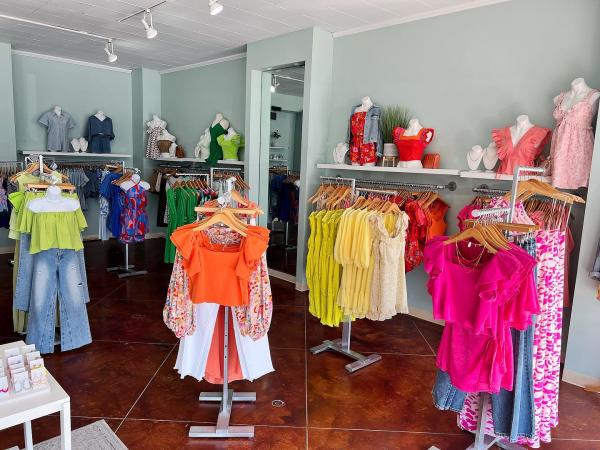A Newbie's Overview to Navigating the Boutique Fashion Scene
A Newbie's Overview to Navigating the Boutique Fashion Scene
Blog Article
Sustainable Fashion: Just How Eco-Friendly Clothing Is Shaping the Future of Design
As the style market faces increasing examination over its ecological effect, the rise of lasting style supplies an appealing option that aligns design with eco-friendly responsibility. boutique fashion. How does this movement absolutely affect the future trajectory of fashion, and what difficulties exist ahead in its prevalent adoption?
Innovative Sustainable Products
As the garment industry faces its ecological impact, cutting-edge sustainable products have become a crucial solution for lowering environmental footprints. Among one of the most promising materials are those stemmed from all-natural, sustainable resources, such as organic cotton, hemp, and bamboo. These products not just decrease dependence on nonrenewable fuel sources yet also decrease dangerous pesticide use and water consumption. Organic cotton, for instance, makes use of considerably much less water than conventional cotton and gets rid of the requirement for harmful chemicals, therefore protecting dirt health and biodiversity.
In addition to plant-based materials, advancements in biofabrication have brought about the growth of lab-grown fabrics. Mycelium leather, acquired from mushroom roots, offers a versatile and biodegradable alternative to animal leather. Its production results in considerably lower carbon exhausts and water use, making it an extra lasting choice for designer looking for to straighten with eco-friendly practices.
Recycled products are likewise getting traction, with polyester made from recycled plastic bottles representing a substantial development. This technology not just diverts plastic waste from seas and garbage dumps but additionally lowers power intake compared to creating virgin polyester. Together, these products highlight the possibility for an extra sustainable fashion business, leading the means for eco aware style and production.
Eco-Conscious Production
Structure on the advancements in sustainable products, the style industry is likewise re-evaluating its production processes to better decrease ecological influence. Trick methods consist of minimizing water usage, lowering carbon emissions, and eliminating harmful chemicals.
An additional crucial element is the decrease of poisonous chemicals commonly utilized in coloring and ending up textiles. Eco-conscious manufacturers are moving in the direction of plant-based dyes and waterless dyeing modern technologies, which not only protect regional communities yet also improve worker safety. Advancements like electronic printing lower textile waste and power intake, supplying a cleaner alternative to conventional techniques.
Additionally, openness and traceability have ended up being vital. With the innovation of blockchain modern technology, firms can now supply in-depth understandings into their supply chains, making sure honest and ecologically friendly techniques at each action. This openness develops consumer trust and encourages brands to maintain high sustainability standards. As the need for eco-conscious items expands, makers are obliged to innovate, ensuring that the future of fashion is both lasting and fashionable.
The Surge of Upcycling
Upcycling, a transformative method in lasting style, includes artistically repurposing disposed of products into new, top quality products. This cutting-edge method not only reduces waste but additionally reduces the need for resources, therefore decreasing the environmental influence of clothes production. By rebuilding and reimagining existing things, designers and fashion brands visit this page have the ability to infuse originality right into their collections while promoting environmental duty.

In addition, the upcycling movement has encouraged small businesses and independent developers, that often lead in advancement as a result of their agility and creativity. By taking advantage of the plentiful schedule of unused products, these entities contribute to a circular economy, showing that fashion can be both stylish and sustainable. Through upcycling, the market takes considerable strides in the direction of a more aware and accountable future.
Thrift Society's Influence
The expanding second hand society considerably reshapes the landscape of sustainable style, stressing the relevance of mindful consumption. This social shift urges customers to accept previously owned garments, consequently reducing the need for brand-new garment production and minimizing ecological effect. Second hand buying not just expands the lifecycle of apparel however additionally reduces the carbon footprint related to manufacturing, transferring, and dealing with garments.
A vital facet find here of second hand culture is its democratization of fashion. By offering a broad array of styles from different eras at budget-friendly rates, thrift stores make style accessible to a more comprehensive target market. This ease of access cultivates a sense of originality and imagination, as customers mix and match one-of-a-kind pieces to curate customized closets without adding to the rapid fashion cycle.
Moreover, thrift culture promotes circularity in fashion, lining up with the principles of a circular economic climate. By recirculating garments, the cycle of waste is disrupted, and resources are preserved. This practice supports a change from a direct "take-make-dispose" version to a much more sustainable structure. As even more customers and developers embrace second hand society, the style market is forced to adjust, incorporating lasting methods to satisfy the growing need for eco-conscious alternatives.

Future Trends in Fashion
Fashion's development is increasingly formed by technological innovations and sustainability-driven efforts. As customers become a lot more environmentally mindful, the market is responding with groundbreaking innovations that redefine the future of style. One noticeable trend is the surge of digital style, where online garments can be put on in enhanced fact environments, dramatically minimizing material waste. This shift not just caters to the digital-savvy consumer yet likewise minimizes the ecological footprint generally related to garment manufacturing.
Moreover, the combination of blockchain innovation provides brand-new opportunities in openness and traceability, allowing consumers to verify the sustainability qualifications of their apparel. boutique fashion. This guarantees responsibility in supply chains and promotes honest sourcing methods. 3D printing is yet one more advancement that assures to change making procedures by making it possible for on-demand manufacturing, therefore reducing excess inventory and waste
As these technologies mature, they are poised to change the style landscape, merging design with sustainability. The future of style, as a result, lies in a smooth blend of technology, development, and environmental responsibility.
Conclusion
The transformation of the apparel industry through lasting methods suggests an essential shift in the direction of environmental accountability. The integration of cutting-edge materials, eco-conscious production methods, and the embracement of upcycling and thrift society underscores a dedication to minimizing these details eco-friendly impacts. As these practices obtain momentum, they redefine the sector's narrative by prioritizing ethical and lasting choices. This development not just straightens style with ecological sustainability however also sets a criterion for future fads concentrated on obligation and innovation.
As the style industry faces increasing examination over its ecological influence, the rise of sustainable style provides an encouraging choice that aligns style with environmental duty.As the fashion market grapples with its ecological effect, cutting-edge lasting materials have emerged as a critical service for decreasing environmental impacts. Together, these products highlight the possibility for an extra lasting style sector, paving the method for ecologically aware design and manufacturing.
Structure on the advancements in lasting materials, the fashion sector is also re-evaluating its production procedures to further lower environmental effect. boutique fashion.Upcycling, a transformative method in sustainable style, involves artistically repurposing discarded products into new, premium items
Report this page